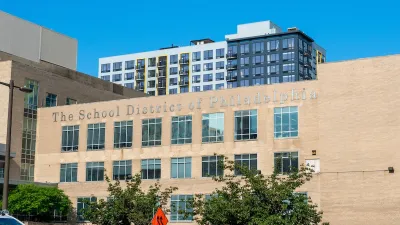The latest test scores from the National Assessment of Educational Progress suggests that student learning has not recovered from its COVID-era decline. Is this more true for urban school districts than for the rest of the United States?

In recent weeks, I’ve seen a few headlines about the latest National Assessment of Educational Progress test scores. A typical reaction came from the federal Department of Education: the results “reveal a heartbreaking reality for American students… the education system continues to fail students across the nation.” And indeed there is more than a grain of reality to support this view: national reading and math scores are at best stagnant. The national average score for reading continued to decline, while the score for mathematics was roughly the same as 2022 results but far below pre-COVID results.
Since my primary interest is in big cities, this data made me wonder: how did urban school districts do? Did they do better or worse than national trends? And did urban school districts did better or worse than the states that surround them? In particular, I focus on reading scores because American students seem to struggle more than reading than in math: Math scores are still far above late 20th-century levels, while reading scores are not.
NAEP has data for city, suburban and rural schools. Since urban schools tend to get more negative publicity than suburban and rural schools, one might think that learning loss was more significant for urban schools as a whole. But this was not the case. 8th-grade reading scores for rural students declined by 6 points between 2019 and 2024 (from 263 to 257 for rural schools, and 266 to 260 for urban schools, and 266 to 260 for suburban schools), but declined by 4 points for urban schools (from 257 to 253). 4th-grade scores were only slightly different: they declined by 4 points for urban schools, 7 points for suburban schools, and 7 points for suburban schools.
In addition to having data for urban schools as a whole, NAEP has data for about two dozen large urban school districts. The average 8th-grade reading score for these large districts declined by only 2 points between 2019 and 2024; however, this average contains a pretty wide variation, including gains in some districts and double-digit losses in others.*
One of the worst districts was Cleveland, where reading scores declined by 11 points between 2019 and 2024, while Ohio-wide results declined by only 2 points. Jacksonville, one of the most politically conservative cities in the NAEP urban sample, experienced a 10-point loss. However, this collapse was not unique to Jacksonville; Florida-wide reading scores declined by 7 points. In Massachusetts, Kentucky and North Carolina reading scores were stable or declined by a point or so- but in Louisville, Boston and Charlotte scores declined by 7-8 points.
At the other extreme, reading scores actually improved by a point or two in Dallas, Chicago, Denver and Washington, D.C. Chicago and Denver results were similar to those in their respective states (as scores were stable in Chicago and rose by two points in Colorado). Dallas schools did a bit better than Texas generally, where reading schools declined by three points. (By contrast, Austin and Houston suffered 2-3 point declines similar to the statewide result, and Fort Worth’s score declined by 5 points). New York reading scores are no worse than they were in 2019, while statewide New York scores declined by five points.
Finally, many cities suffered from modest declines roughly comparable to statewide results. For example, Los Angeles and San Diego reading scores declined by one and three points respectively, slightly better than California’s five-point statewide average. In Milwaukee and Baltimore, both city scores and statewide scores declined by 1-2 points. In Philadelphia, reading scores declined by one point, while Pennsylvania statewide scores increased by one point. In Detroit and Atlanta, reading scores declined by five points while statewide scores declined by similar amounts (one point in Georgia, four points in Michigan).
In sum, the bad news is that in most of the United States, test scores are still headed in the wrong direction. The good news is that this is not any more true in urban school districts than it is elsewhere.
*I note that 4th-grade reading scores also declined by less in large urban districts than in the rest of the nation (3 points in large districts, 5 points nationally). Because these results seem similar to the 8th-grade results, I don't think it would add very much to discuss 4th-grade scores separately.

Maui's Vacation Rental Debate Turns Ugly
Verbal attacks, misinformation campaigns and fistfights plague a high-stakes debate to convert thousands of vacation rentals into long-term housing.

Planetizen Federal Action Tracker
A weekly monitor of how Trump’s orders and actions are impacting planners and planning in America.

In Urban Planning, AI Prompting Could be the New Design Thinking
Creativity has long been key to great urban design. What if we see AI as our new creative partner?

King County Supportive Housing Program Offers Hope for Unhoused Residents
The county is taking a ‘Housing First’ approach that prioritizes getting people into housing, then offering wraparound supportive services.

Researchers Use AI to Get Clearer Picture of US Housing
Analysts are using artificial intelligence to supercharge their research by allowing them to comb through data faster. Though these AI tools can be error prone, they save time and housing researchers are optimistic about the future.

Making Shared Micromobility More Inclusive
Cities and shared mobility system operators can do more to include people with disabilities in planning and operations, per a new report.
Urban Design for Planners 1: Software Tools
This six-course series explores essential urban design concepts using open source software and equips planners with the tools they need to participate fully in the urban design process.
Planning for Universal Design
Learn the tools for implementing Universal Design in planning regulations.
planning NEXT
Appalachian Highlands Housing Partners
Mpact (founded as Rail~Volution)
City of Camden Redevelopment Agency
City of Astoria
City of Portland
City of Laramie






























